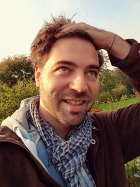A little about loopbio
Loopbio was founded in 2015 by Max Hofbauer and John Stowers to bring advances in image processing, tracking, deep learning, video recording and laboratory automation technology to the Natural Sciences. Being scientists and engineers ourselves, we appreciate how important technology is to scientific discovery, and we aspire to provide cutting edge solutions to help Scientists answer their research questions. Our dedication and excellence has been recognised by customers throughout the world, and by our acceptance in the prestigious NVIDIA Inception program, and the edmund optics startUP program.


A little about the founders

Max Hofbauer (co-founder), MSc
Max trained as a biologist at the University of Vienna, but was introduced to Virtual Reality during his masters studies "Behavior, Neurobiology, and Cognition" in the lab of Axel Schmid. There, Max combined his interest in the visual perception of animals with a fascination for technology, to develop an Arthropod VR system for freely walking spiders - including real-time position tracking and motion compensation. Max then moved to the labs of Andrew Straw and Kristin Tessmar-Raible where he worked on the development of VR systems for freely swimming fish, and automated behavioral analysis using computer vision. Max believes quantitative behavioral analysis can lead to new scientific insight and is passionate about closing the gap between engineering, data analysis, and traditional biology.
 loopbio
loopbio